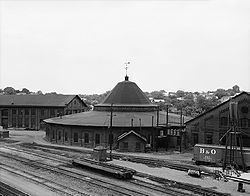Built 1866 NRHP Reference # 03001045 Area 1 ha | Architectural style Other Opened 1866 | |
 | ||
Added to NRHP 000000002003-07-31-0000July 31, 2003 Designated NHL 000000002003-07-31-0000July 31, 2003 Similar Balti and Ohio and Relat, Continental Clay Brick Plant, Boydville, Adam Stephen House, Apollo Theatre | ||
Baltimore and Ohio Railroad Martinsburg Shops is a historic industrial district in Martinsburg, West Virginia. It is significant both for its railroading architecture by Albert Fink and John Rudolph Niernsee and for its role in the Great Railroad Strike of 1877. It consists of three contributing buildings. The presence of the Baltimore and Ohio Railroad Company in Martinsburg dates back to the late 1840s when the first engine and machine shops were erected for the expanding company.
Contents
Ante bellum history
Civil War history
When Virginia seceded from the Union in 1861, the region's social and government institutions were thrown in turmoil. The Civil War decimated both the region and Martinsburg, specifically because of the railroad yards.
Post bellum history
In 1866, the B&O began reconstruction of the roundhouse and associated shops that stand on the site today, which were completed in 1872.
Modern history
The facilities were used until the mid-1980s when all local operations were transferred to other locations and the complex remained vacant until restoration began in 1999.
